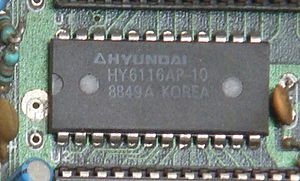Static RAM facts for kids

Static Random Access Memory (SRAM) is a special kind of RAM. It's like a computer's short-term memory. SRAM can hold onto data without needing constant refreshing. This makes it very fast.
Both SRAM and DRAM store information. They use tiny electronic components to hold data in binary form. Both types of memory are volatile. This means they need electricity to keep the data stored. If the power turns off, the data is lost.
SRAM is often used in places where speed is super important. It's found in parts of a PC where its speed helps a lot.
Like other semiconductor chips, SRAM chips are made using a process called Photolithography. This process helps create the tiny parts on the chip.
Contents
What is SRAM?
Each tiny piece of information, called a bit, in SRAM is made of several transistors. Usually, it takes between four and six transistors to store just one bit. These transistors are like tiny switches that hold the data.
Because each bit needs so many transistors, SRAM chips take up more space. They also use more power than DRAM. In comparison, DRAM uses only one transistor and a capacitor per bit. A capacitor acts like a tiny rechargeable battery.
Why SRAM is Good
SRAM has some great advantages:
- No Refresh Needed: SRAM does not need to be refreshed. This means it doesn't have to be constantly re-energized to keep its data. This makes it simpler and faster.
- Faster Performance: Changing or reading data from SRAM is much faster than with DRAM. This speed is a big reason why it's used in specific computer parts.
Why SRAM is Not Always Used
Even with its speed, SRAM has some downsides:
- More Expensive: SRAM costs more to make than DRAM. This makes it more expensive for computer builders.
- Takes More Space: Because each bit needs more parts, SRAM chips are larger. This means less memory can fit into the same amount of space.
- Uses More Electricity: SRAM also uses more power than DRAM. This can be a concern for devices that need to save battery life.
Where SRAM is Used
SRAM is often used as a computer's cache memory. Cache memory is a very fast, small memory that stores data the CPU needs often. This helps the computer run much faster. SRAM is also used in routers, printers, and other devices where quick access to data is key.
Images for kids
-
SRAM cells on the die of a STM32F103VGT6 microcontroller as seen by a scanning electron microscope. Manufactured by STMicroelectronics using a 180-nanometre process. Topology of the cells is clearly visible.
-
Comparison image of 180 nanometre SRAM cells on a STM32F103VGT6 microcontroller as seen by an optical microscope
See also
 In Spanish: SRAM para niños
In Spanish: SRAM para niños


